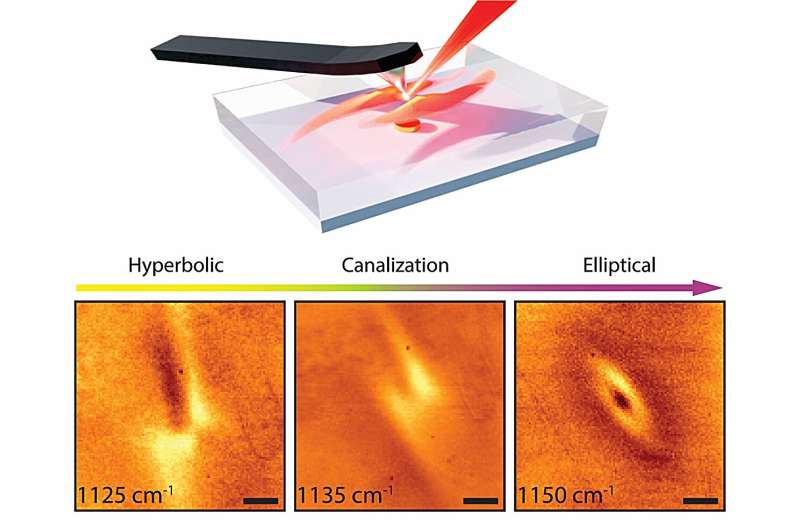Science
Researchers Uncover New Light Behavior in Gypsum Mineral

A recent study led by researchers from the National Graphene Institute at the University of Manchester and the University of Oviedo has unveiled a novel behavior of light in the mineral gypsum, commonly used in building materials like plaster and chalk. Published in the journal Science Advances on July 21, 2025, the findings reveal the presence of a rare wave type known as a shear phonon polariton in a two-dimensional form of gypsum.
Phonon polaritons represent a unique interaction between light and atomic vibrations within specific crystals. These hybrid waves can travel through materials in unconventional manners and are capable of concentrating light into remarkably small volumes. The research team discovered that in thin films of gypsum, these waves undergo a significant topological transition. This shift allows the waves to change from a hyperbolic to an elliptical propagation mode while passing through an intermediate canalized state.
Dr. Pablo Díaz Núñez, a co-leader of the study, explained the importance of their findings. “Previous studies on shear phonon polaritons were confined to bulk crystals in the hyperbolic regime. Our research expands on those initial findings by examining shear polaritons in two-dimensional materials,” he stated. “Remarkably, we found that shear phonon polaritons in gypsum support a topological transition, allowing for both hyperbolic and elliptical propagation with canalization in between.”
The implications of this research are significant. The team succeeded in confining light to a space that is twenty-five times smaller than its wavelength, significantly slowing it down to a fraction of its speed in a vacuum. This advancement opens new avenues for manipulating light at the nanoscale, which may lead to innovative applications in various fields.
The study also emphasizes the role of crystal symmetry in these processes. Gypsum is classified within the monoclinic crystal system, characterized by low symmetry. This unique structure results in asymmetric light propagation and energy loss, both crucial features of shear polaritons. These findings extend beyond the fundamental research of phonon polariton propagation, with potential applications in thermal management, precision sensing, and advanced imaging techniques that exceed the limitations of conventional optics.
Moreover, the research positions gypsum as a promising platform for investigating advanced photonic concepts, particularly in the emerging area of non-Hermitian photonics. As scientists continue to explore the capabilities of this mineral, the potential for groundbreaking developments in light manipulation appears increasingly tangible.
The study, titled “Visualization of topological shear polaritons in gypsum thin films,” is set to contribute significantly to the growing body of research focused on innovative photonic materials and their applications.
For more detailed insights, refer to the original publication in Science Advances.
-

 Technology5 months ago
Technology5 months agoDiscover the Top 10 Calorie Counting Apps of 2025
-

 Health2 months ago
Health2 months agoBella Hadid Shares Health Update After Treatment for Lyme Disease
-

 Health3 months ago
Health3 months agoErin Bates Shares Recovery Update Following Sepsis Complications
-

 Technology4 months ago
Technology4 months agoDiscover How to Reverse Image Search Using ChatGPT Effortlessly
-

 Technology1 month ago
Technology1 month agoDiscover 2025’s Top GPUs for Exceptional 4K Gaming Performance
-

 Technology2 months ago
Technology2 months agoElectric Moto Influencer Surronster Arrested in Tijuana
-

 Technology5 months ago
Technology5 months agoMeta Initiates $60B AI Data Center Expansion, Starting in Ohio
-

 Technology5 months ago
Technology5 months agoRecovering a Suspended TikTok Account: A Step-by-Step Guide
-

 Health4 months ago
Health4 months agoTested: Rab Firewall Mountain Jacket Survives Harsh Conditions
-

 Lifestyle5 months ago
Lifestyle5 months agoBelton Family Reunites After Daughter Survives Hill Country Floods
-

 Technology4 months ago
Technology4 months agoHarmonic Launches AI Chatbot App to Transform Mathematical Reasoning
-

 Technology3 months ago
Technology3 months agoUncovering the Top Five Most Challenging Motorcycles to Ride





















